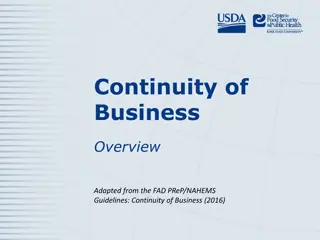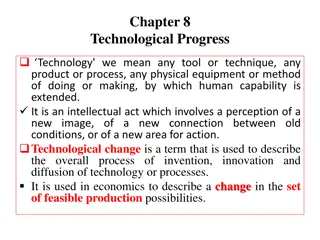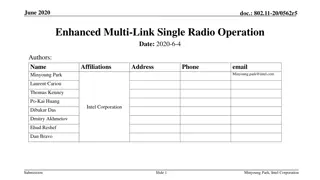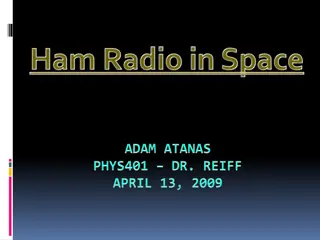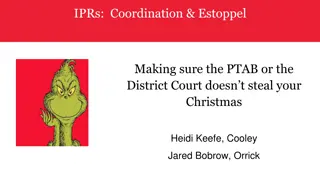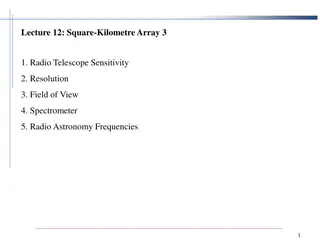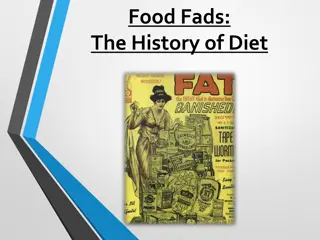Radio in Its Golden Age: From Invention to Fad
Radio, invented by Guglielmo Marconi in 1901, faced skepticism before proving its worth with the first transatlantic signal. Despite slow commercial adoption, the vacuum tube enabled voice broadcasts. The first US scheduled broadcast in 1920 marked a turning point, and radio soon became a popular fad with ready-made sets hitting the market by 1921.
Download Presentation

Please find below an Image/Link to download the presentation.
The content on the website is provided AS IS for your information and personal use only. It may not be sold, licensed, or shared on other websites without obtaining consent from the author. Download presentation by click this link. If you encounter any issues during the download, it is possible that the publisher has removed the file from their server.
E N D
Presentation Transcript
Radio in its golden age
Beginnings Radio was invented by an Italian, Guglielmo Marconi who patented the strange thing in 1901. Some people were fairly skeptical of the idea that voice could be sent invisibly over thousands of miles of air. Well, who wouldn t be? Sounds like believing in ghosts.
Beginnings Marconi proved this crazy idea to be nevertheless true: he sent s signal from Cornwall in England to Newfoundland in Canada, the first transatlantic signal.
The wait Marconi won a Nobel Prize for his invention, and rightly so. But commercial radio, like commercial television and internet, was slow in starting. By 1914 it was still experimental. Average folks didn t have receivers.
First broadcast First radio was in Morse Code only, so not accessible to the general population. Lee DeForest, an American, invented the vacuum tube to allow broadcast in voice.
First broadcast The first U.S. scheduled radio broadcast was Nov. 2, 1920, in East Pittsburgh. Called KDKA radio, 100-watt transmitter. It was an evening broadcast announcing the results of the presidentail election between Warren Harding and James Cox. As few people owned receivers, it didn t create much excitement.
What to do? Radio was well established among the military and shipping. But people couldn t think of a good reason for it among average people. Who needs radio?
Promotion Westinghouse Electric Co. tried promoting it. Finally it managed to make the public pay attention. Boom! Radio was the new fad. What to call this strange device that pulled some invisible voices from the ether, as it was called then? Wireless telephone, wireless musicbox, radio telephone or simply radio?
First sets Radios at first needed home assembly, like a crystal set you can buy nowadays at a toy store. But by 1921 stores were selling ready-made products. First radios sold by the thousands, even though they lacked speakers. You needed a headphone.
Stations Okay, so you sell people radios, you have to give them somthing to listen to. Many businesses and individuals set out to acquire federal commercial radio licenses. They were easy to get.
Early stations Those acquiring licenses included Gimbel s Department store (WWP, Philadelphia), Ford Motor Co. (WWI, Detroit), Omaha Grain Exchange (WAAW, Omaha), St. Matthew s Cathedral (KFBY, Laramie, Wyoming). And, of course, Fargo s Forum Communications Co., which launched the area s oldest station in 1922: WDAY.
Radio growth Westinghouse launched three new stations. Universities saw academic potential, and by the end of 1922, 74 had stations. The NDSU engineering department was granted a license in December 1922, 50-watt transmitter, 832 on the AM dial, WPAC. But the department dropped the station in 1926 as commercial competition crowded air waves.
NDSU radio NDSU launched another radio station in 1952, KDSU. In 1999 that station was absorbed by Prairie Public Broadcasting. KNDS was launched a few years later for student use.
Growth In the two years following that first broadcast, radio in the United States grew to 550 stations, with 1.5 million radio sets sold.
Programs As it was at first a novelty, people weren t fussy about programming. Stations went on the air when they had something to broadcast at specific times, then off the air after. Broadcasts comprised scratchy recorded music, live performances, or lectures.
Programs At first no drama or comedy was available. Soon after 1922, however, radio dramas debuted. Broadcasters discovered these would be a lot less boring if sound effects were added.
Sound effects Early radio sound effects: Roar of blowtorch and breaking matches near mic=forest fire. Rolling dried peas in a paper tube=rain on a roof. Waving a sheet of metal=thunder.
Dramas Creative additions like these made dramas more appealing. Politicians made radio more important. They adapted quickly. Radio, after all, was becoming a way to reach millions of people.
First radio presidents Harding was the first radio president, broadcasting his speeches. By 1925, Calvin Coolidge s inaugural address was heard by 25 million on radio. Radio had become a force in society.
Coolidges voice Silent Cal had a soft, boring voice. Radio worked in his favor, added a dynamic quality to the voice. Furthermore, Coolidge did not look presidential to some people. His victory may possibly be credited to his radio presence in a pre-television era.
Coolidge on film Actually, while television didn t exist, Coolidge was recording in an early newsreel with sound! I don t think he was all that bad, despite what they said .
Franklin Roosevelt Franklin Roosevelt, however, was the radio president par excellence. His Fireside Chats during the Great Depression proved him a master of the medium, who could speak directly and intimately to the public.
Fireside chats Roosevelt s Fireside Chats on radio inspired a fearful nation during a dark time. http://www.youtube.com/watch?v=jt9f-MZX-58
Sports Sports reached radio early in its commercial development. Baseball, football and boxing were most popular during this era. The blow-by-blow description premiered in 1921 as an announcer described a fight between Jack Dempsey and George Carpenter.
Music Music also appeared right away. Most of it was classical. Many people had never heard much classical music.
Growth By 1925 millions owned radio sets, and antennas littered the roofs. People planned their day around radio programs. Clearly, broadcast had become a powerful force in society. The prospect of profit attracted big business to the new medium.
New companies In addition to Westinghouse, companies interested in radio included GE, AT & T, RCA and United Fruit Co. These conspired to create a monopoly over high-powered broadcasts, but it didn t work. Growing out of these was the radio network NBC.
Problem: profit But if the potential radio audience was growing to be huge, commercial operators still faced a problem: how to make money. The problem was listeners could tune in for free. But talent had to be paid, and ASCAP lawyers began to demand payment for using recorded music. Yet early audiences detested the idea of on-air advertising.
Paying for radio European models suggested taxing radio owners to pay for programming. Other people advocated donations. Some suggested subscriptions. Taxing makers of radio sets could be tried. Perhaps descrablers could be sold.
Paying for radio David Sarnoff, head of RCA, the parent company of NBC network, vigorously opposed taxing listeners. He thought the great power of radio in a democracy was its ability to reach everybody.
First commercial The first radio commercial aired August 1922, in New York. It was rather successful, so other stations copied the idea, called toll radio. Listeners began to accept advertising because it improved the quality of programming.
Ad success By 1925 advertising had grown to dominate radio. Broadcasters began naming programs after their sponsors. As it seemed inevitable that this new medium in America would develop into a commercial, profit- driven business, early advertising opponents, such as Sarnoff, joined the bandwagon.
Power problems As radio developed rapidly, so did problems regarding transmissions. Larger stations were able to block weaker signals and so eliminate competing stations. Operators turned to the government to regulate frequencies and power.
Regulation The Radio Law of 1912 had earlier set up a licensing plan for experimental stations. By 1922, Herbert Hoover, then commerce secretary, moved to find a better solution. Regulation came slowly, however, as a Republican administration brought an anti-government control philosophy to broadcast.
Regulation Hoover s hands-off approach in effect made him an influential figure for radio s early development because he left that development to the country s private industry. In 1927 Congress finally established the Federal Radio Commission to oversee the industry (changed to Federal Communication Commission in 1934).
Regulation Hoover s policy of low control favored growth of an advertising-based, commercial radio industry geared toward mass audience programming. Other countries considered more educational, non- commercial programming. The United States approach to radio set a pattern that was followed later as television developed.
Networks NBC was established in 1926, CBS in 1927. Programming shifted from mostly local to mostly national, limiting local influence. People began to enjoy the opportunity to hear national celebrities, and those celebrities saw their popularity grow with national exposure something only the national networks could provide.
NBC Network NBC was actually two networks, the Blue and the Red. These were named after the network of colored lines linking stations on company maps. The rival was CBS, under William S. Paley.
Early programs Radio programming usually was a variety of music, drama, comedy, talk, an occasional celebrity show a format typical of traditional television programming today. Specialized radio formatting didn t exist until the 1950s. Comedy shows became the rage in 1929, with the introduction of Amos and Andy, two white guys acting like black characters.
Amos and Andy We can still hear historical Amos and Andy programs today. http://archive.org/details/AmosAndy_373
Fad fades In the 1930s, the red-hot radio fad began to fade. Stations scrambled to find programing to attract people back. Ad agencies began to take over program production from the networks, something that migrated to early television. In fact, if a radio personality wanted a job, he or she wouldn t approach a station, but an ad agency.
Sponsor power Commercial radio sponsors became powerful controllers of what people heard. Content often became simply a vehicle for a commercial message. Nevertheless, people still liked radio, and research indicates national networks played a major role in tying together many different American regional factions into a more fully united nation.
Radio and values Radio broadcast the same celebrities from coast to coast. It projected everywhere the same values and attitudes. By the 1940s, radio hours were second only to sleeping in an average American s leisure life. Radio was a thread that tied the country together.
Genres By the late 1930s radio had developed all the genres familiar to us today: Western, detective, soap opera, comedy, romance, serious drama. Broadcast news and quiz shows also were introduced.
News News became particularly important, with Roosevelt s Fireside Chats. Radio news personalities developed into celebrities: Lowell Thomas, H.V. Kaltenborn, Dorothy Thomas and, of course, Edward R. Murrow during World War II.
War of the Worlds H.G. Wells novel War of the Worlds on Oct. 30, 1938, was broadcast in a way so real some people actually thought Earth was being invaded by aliens. http://www.youtube.com/watch?v=Xs0K4ApWl4g Orson Welles was producer.
Radio in war Radio during World War II became a principal propaganda tool for both allies and axis nations. Edward R. Murrow s broadcastsduring the London bombing established his fame as the country s greatest news figure of the era. http://www.youtube.com/watch?v=6KLQxtDOkZA
Radio in war Americans also heard one of the war s greatest radio speakers, Winston Churchill of Britain. His voice inspired Americans to support the allies. http://www.youtube.com/watch?v=G4BVzYGeF0M&fea ture=related
Eve of radio era After World War II radio tried to find a new direction. Quiz shows were ressurected. By 1948 radio stations were giving away $7 million a year. But television challenged a medium that did not know how to respond.
Competition Radio tried to compete with television by producing new and better programs. But radio trailed badly. By 1955 not a single evening radio program was in the Nielsen Ratings top 10. By 1960 not one soap opera remained on radio.
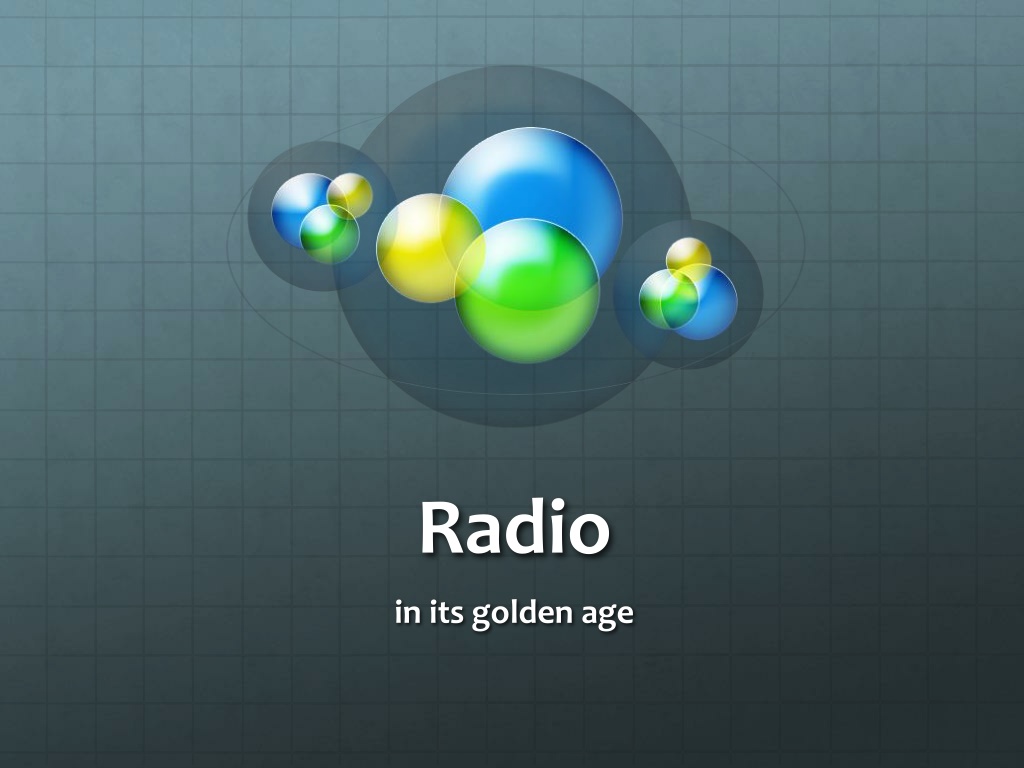

![❤[READ]❤ Robotic Exploration of the Solar System: Part I: The Golden Age 1957-19](/thumb/21623/read-robotic-exploration-of-the-solar-system-part-i-the-golden-age-1957-19.jpg)



